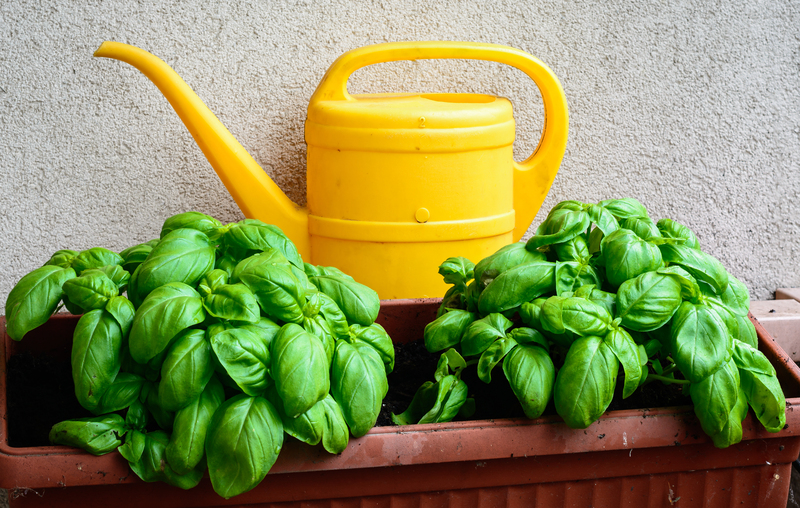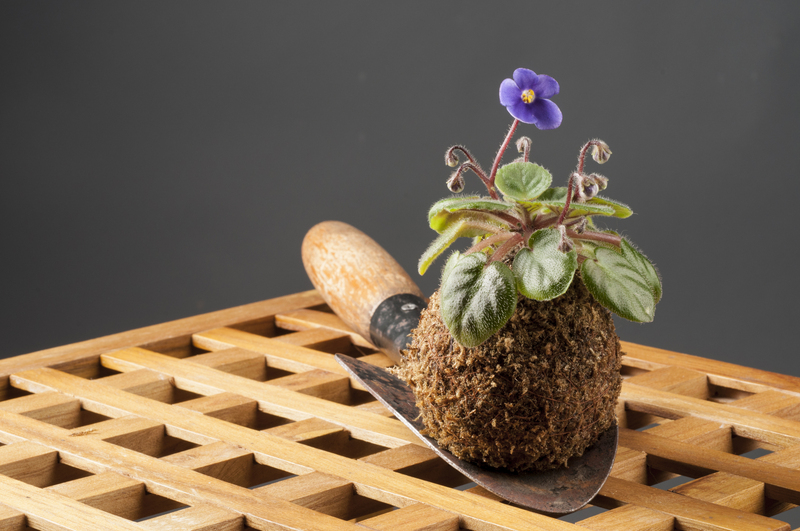Botanical Bonds: Creating Dog-Integrated Greenscapes
Posted on 12/09/2025
Botanical Bonds: Creating Dog-Integrated Greenscapes
In the evolving world of landscape design, a fresh trend is sprouting: dog-integrated greenscapes. These botanical bonds between humans, plants, and their canine companions foster a harmonious balance of eco-friendly beauty, functionality, and canine well-being. Join us as we explore how to seamlessly blend the needs of your beloved pet with lush landscapes, transforming your outdoor space into a haven for both flora and four-legged friends.
Why Dog-Friendly Landscapes Matter
Pet ownership is at an all-time high, and dogs are not just pets--they're cherished family members. As such, integrating canine needs into greenscape design is more than a trend; it's a necessity for ensuring both safety and enjoyment. Dog-integrated greenscapes don't just look beautiful--they create environments where botanical and canine lives can flourish side-by-side.
- Healthier dogs: Natural surfaces are gentler on paws, and strategic landscape choices can encourage exercise and mental stimulation.
- Improved plant health: Choosing the right dog-friendly species prevents unintentional harm from digging or toxic ingestion.
- Increased property value: Pet-centric landscapes are highly desirable among modern homebuyers.
- Environmental benefits: Native plants and sustainable materials reduce maintenance and chemical use, promoting biodiversity.

Understanding Your Dog's Outdoor Behaviors
Before you design your dog-integrated greenscape, observe your dog's habits. Every canine is unique--some love to dig, some need to run, and others prefer lounging in the shade. Evaluating your pup's favorite activities will help tailor the landscape to your pet's enjoyment and safety.
- Pathways: Many dogs instinctively patrol borders or follow familiar routes--incorporate these "dog runs" into pathways.
- Shady spots: Dogs often seek shade, so integrating trees or pergolas is key.
- Play zones: Watch for areas your dog uses for play and ensure these have durable, paw-friendly surfaces.
- Rest areas: Even energetic breeds need quiet zones with comfortable ground cover for relaxation.
Design Principles for Dog-Integrated Botanical Landscapes
The heart of dog-integrated greenscape design lies in balancing aesthetics, practicality, and safety. Here's how to approach each design component for the best results:
1. Safety First: Pet-Proofing Your Greenscape
- Secure fencing: Protect your dogs--and your plants--by ensuring perimeter fencing is sturdy and escape-proof.
- Toxicity awareness: Many decorative plants are poisonous to dogs. Avoid sago palm, oleander, azalea, and foxglove. Instead, favor dog-safe plants like camellia, sunflowers, or rosemary.
- Mulch selection: Opt for pet-friendly mulch such as untreated wood chips. Avoid cocoa mulch, which is toxic to dogs.
- Water safety: If you have ponds or fountains, ensure dogs can enter and exit easily, or provide barriers if water safety is a concern.
2. Pathways and Dog Trails
Dogs are creatures of habit. Honor their chosen routes with botanical pathways using materials that are gentle on paws--think flagstone, decomposed granite, or artificial turf.
- Narrow trails: Line with low-growing, non-toxic plants that won't snag fur.
- Hidden agility: Integrate gentle curves, tunnels, or small steppers to create interest and mental stimulation.
3. Durable Play Zones
- Lawn alternatives: Heavy-pawed dogs can destroy traditional grass. Try clover, buffalo grass, or bark mulch that resists digging and trampling.
- Interactive features: Logs, boulders, and constructed hills serve double duty for canine exploration and garden interest.
4. Sensory Stimulation: Enriching Canine Minds
A dog-integrated botanical space should be a feast for all senses. Incorporate the following:
- Textures: Combine soft grasses with rough flagstones for paw variation.
- Scents: Culinary herbs like mint, thyme, and lavender are non-toxic and provide rich, safe olfactory exploration.
- Sounds: Gentle wind chimes or water features offer calming background noise.
5. Shady Havens and Weather Protection
- Trees and shrubs: Willows, birches, and spruces provide excellent canopy.
- Artificial structures: Pergolas, trellises, and dog houses shield from hot sun or rain while enhancing landscape design.
Selecting Flora for Dog-Friendly Greenscapes
Choosing the right plants is crucial in creating a canine-compatible botanical garden. Focus on non-toxic, resilient, and low-maintenance species that will survive trampling or chewing.
Dog-Safe Plant Recommendations
- Grasses: Buffalo grass, fescue, zoysia--tough, resilient, and soft on paws.
- Groundcovers: Creeping thyme, Irish moss, or blue star creeper resist damage and keep paws clean.
- Flowering plants: Marigolds, calendula, snapdragons--colorful and non-toxic.
- Herbs and Aromatics: Chamomile, parsley, rosemary, sage, and basil engage canine senses and repel pests.
- Trees and Shrubs: Hawthorn, magnolia, bamboo, and dogwood provide dappled shade and visual interest.
Plants to Avoid in Dog-Integrated Greenscapes
- Toxic plants: Sago palm, azalea, oleander, foxglove, lilies, yew, and mushrooms (avoid wild fungi at all costs).
- Spiny/thorny species: Roses, barberry, and cacti risk injury during play.
- Foxtails and burrs: These grass seeds can embed in paw pads or noses, leading to infections.
Soil, Surfaces, and Maintenance for Dog-Integrated Gardens
The wrong surface can ruin an otherwise perfect greenscape. Focus on resilient surfaces and ease of cleanup:
- Artificial turf: A solution for designated play zones given its durability and low maintenance, but be aware of potential overheating and sanitation concerns.
- Natural turf: Choose hardy species and keep lawns healthy with regular aeration and dog-safe fertilizer.
- Gravel or decomposed granite: Great for pathways, but avoid sharp edges and use containment borders to prevent scattering.
- Mulch and bark chips: Use untreated, pet-safe mulch; replace regularly to reduce fungi and odors.
Cleaning and Sustainability Tips
- Pet-safe cleaners: Use only non-toxic products on patios and hardscapes.
- Compost dog waste with caution: Never use on edible gardens, as pathogens can persist.
- Irrigation: Consider drip systems to avoid overwatering muddy zones frequented by dogs.
Botanical Bonds: The Benefits of Integrated Living
Fostering botanical bonds between humans, dogs, and plants unlocks numerous advantages:
- Well-being and enrichment: Dogs experience fewer behavioral problems when outdoor spaces are engaging and safe.
- Community and connection: Dog-friendly landscapes often become neighborhood gathering spots, promoting social interaction and shared enjoyment of nature.
- Biodiversity support: Integrating native plants and habitat features attracts birds, beneficial insects, and pollinators, building a liveable ecosystem for all.
Step-by-Step Guide: Designing Your Dog-Integrated Greenscape
- Observe your dog: Track activity patterns and favorite zones for a week.
- Map your space: Draw a sketch of your yard, including current plants, fences, and paths.
- List goals: Prioritize safety, play, shade, privacy, or beauty.
- Select dog-friendly surfaces and plants from the above recommendations.
- Install or upgrade fencing as needed for security.
- Create zones for play, rest, potty areas, and sensory stimulation.
- Set up watering stations or splash pads for cooling off.
- Introduce agility or enrichment features like ramps, logs, or digging pits.
- Maintain and adapt as seasons--and your dog's habits--change.

Dog-Integrated Botanical Greenscapes: Common Questions
How do I stop my dog from destroying my plants?
Establish clear boundaries using natural barriers, raised beds, or chicken wire until plants are established. Offer alternatives for digging and gnawing, like a designated sandpit or dog-safe chew toys.
Can a botanical garden be both beautiful and dog-friendly?
Absolutely! Strategic plant choices, creative pathways, and focal points like boulders or sculptures can merge lush aesthetics with pet practicality. The key is harmony, not sacrifice.
Are there dog breeds that require special landscape design?
Active, high-energy breeds (e.g., Border Collies, Retrievers) need more running and play space, while smaller or less active breeds may prefer plush, shady spots. Always tailor your landscape to your breed's size, temperament, and instincts.
How often should I maintain my dog-integrated greenscape?
Weekly spot-clean pet areas, refresh mulch as needed, prune back overgrowth, and evaluate fences and play features for wear. Regular care keeps your canine-integrated greenscape safe and stunning year-round.
Conclusion: Growing Botanical Bonds, One Paw at a Time
Creating dog-integrated greenscapes isn't just a landscaping trend--it's a lifestyle shift that prioritizes the health, safety, and happiness of the entire household, furry members included. By fostering these botanical bonds, you embrace an outdoor living space that becomes a source of joy, relaxation, and sustainable beauty.
Whether you're starting from scratch or transforming an existing yard, the path to a dog-integrated botanical sanctuary starts with thoughtful planning, the right plant palette, and a vision of shared outdoor enrichment. Invest in a design that makes tails wag and blossoms bloom; your home, your dog, and your garden will all thrive.
Ready to cultivate your perfect pet-friendly greenscape? Begin today, and discover the grassroots joy of botanical bonds with your canine companion!

